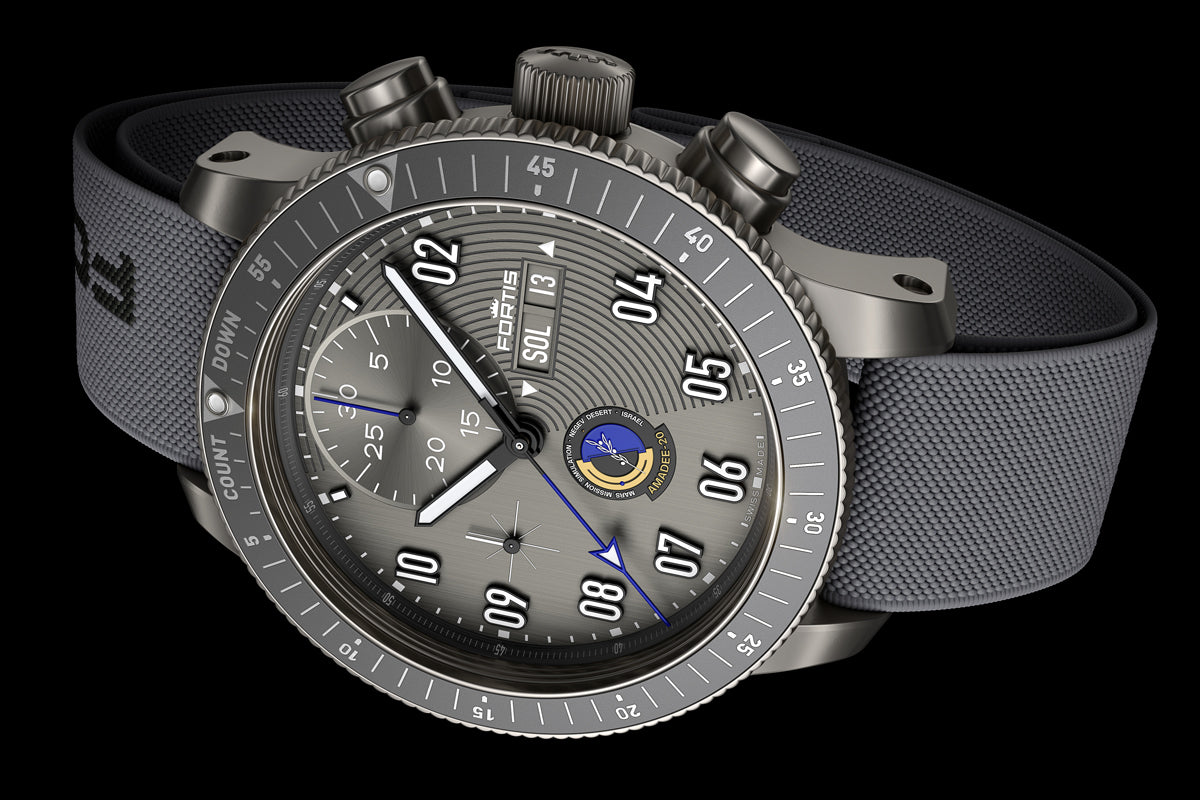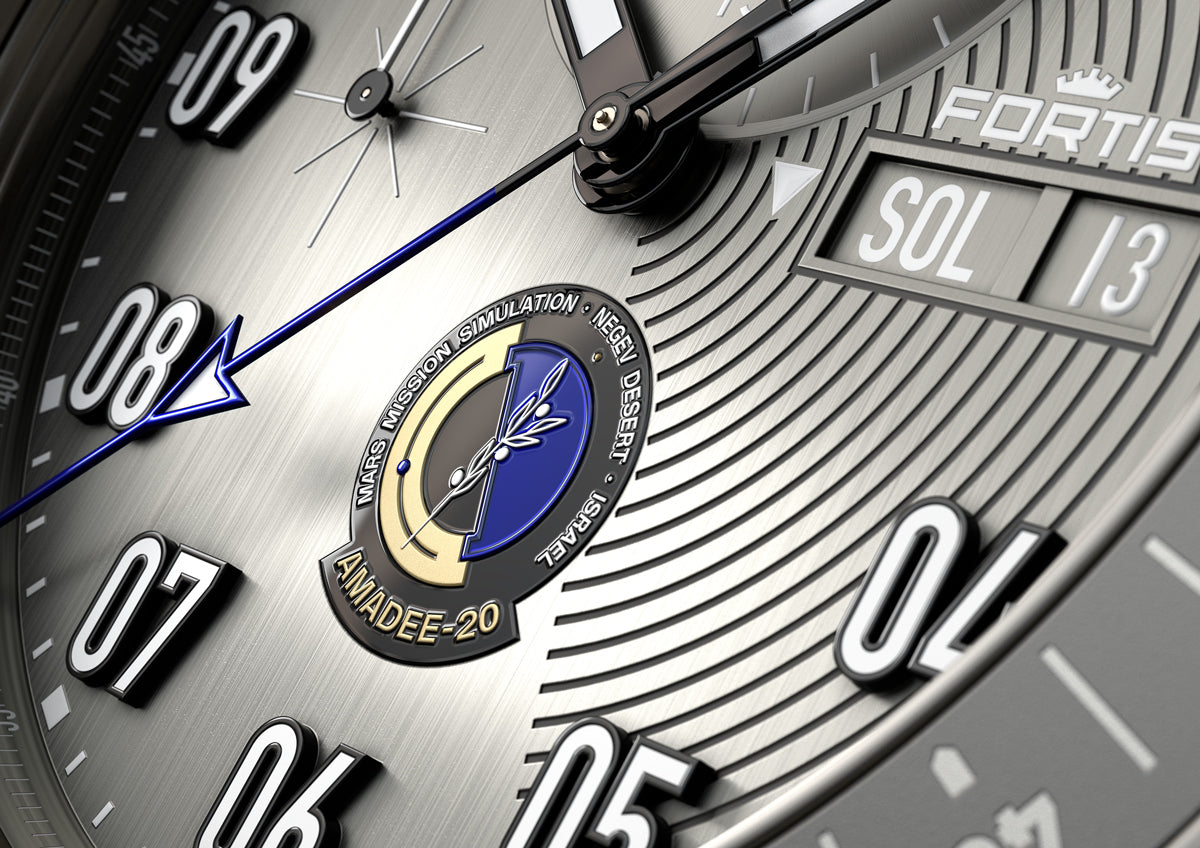Fortis builds on its cosmonauts connection by releasing an impressive new space watch
Much has been written about the Omega Speedmaster as official NASA equipment; and rightly so. There are few such iconic watches in human history and the classic Moonwatch will hold a legendary and hugely desirable status for decades to come. To be clear I am referring to Omega model 311.30.42.30.01.005, not the later enhanced models with crystal case backs or Co-Axial movements.
However, the exploration of another, more distant, planet beckons and we cannot help but wonder what time piece will become standard equipment for the most ambitious manned space mission to date - Mars.
For those of us fascinated by watches linked to space exploration there is much speculation regarding what equipment will eventually travel to the red planet. Hollywood has explored the possibilities, most notably with Matt Damon’s black PVD Hamilton Khaki Navy BeLOWZERO 1000m in The Martian (nice look but very impractical) and the more sensible Omega X-33 Gen 1 which accompanied the crew in Mission to Mars.
The final watch choice for future deep space missions will be subjected to extreme testing and be required to cope with long term survival in the harshest of environments. Exploring the Moon was tough, but the Speedmasters and single Bulova which accompanied the Apollo 11-17 astronauts only had to undertake hours of actual lunar exposure which still imparted serious damage to the case and glass. Current issue NASA and ESA International Space Station watches comprise Omega X-33s, Fortis B42s and private watches such as a Tissot T-Touch. They exist in a highly sterile environment (except for the odd EVA) and remain untested for planetary missions.
No watch has been subjected to the type of exposure expected during a Mars mission so a comprehensive land-based trial and evaluation exercise will be necessary. How will this be achieved from Earth?

The Fortis AMADEE-20 - Image Credit: Fortis
Mars is very much at the forefront of public interest space exploration thanks to recent footage from the Perseverance Rover. Today’s camera technology is (literally) a world apart from the grainy Apollo film of the 1960s and the multi-angle descent video of Perseverance being lowered onto the Martian surface by its delivery craft will go down as some of the best space exploration film of all time. Just when you think it cannot get better, we are now being spoiled with early test footage from the Ingenuity micro-helicopter being flown from the rover.
Whether we see humans walk on Mars in this generation is of course another matter but preparation for that event is well under way with the expectation that it will take decades to understand how to achieve this. The distances to Mars are vast. To put it in some perspective, Apollo 8 was the first, manned, Earth launched vessel to orbit the moon. It took 68 hours to reach Lunar Orbit. A spacecraft will take between 180 and 300 days to reach Mars depending on the planet’s orbit and how much fuel you can carry. The crew of this ship will be, to all intents and purposes, stranded on Mars for over a year and must be totally self-reliant.
In an emergency scenario, Apollo astronauts knew they could get home in around three days, as was the case with mission 13. In space terms this is relatively quickly. There is no such exit for Mars explorers therefore it is critical to future missions that highly accurate rehearsals take place, with qualified participants willing to isolate long term in replicated Martian conditions. To date the most ambitious of these projects is AMADEE-20.

The Fortis AMADEE-20 - Image Credit: Fortis
A comprehensive 10-year simulation project founded in 2018, AMADEE is the flagship of the Austrian Space Forum. Mission operations will last till 2028. It is a mechanism for the development of hardware, work processes and the science behind future human/robotic Mars planetary surface missions.
The project is based upon the vast amount of knowledge and operational expertise gained during the 2007 PolAres program and previous AMADEE ventures in Austria and Oman which resulted in the development of next-gen spacesuits and a surface rover program. The principle scientific objectives of AMADEE-20 will be astrobiology, operational knowledge, and mission architecture with experiments being extended to consider the possibility of exploring Phobos and Deimos, the moons orbiting Mars.
The actual field mission “Planet” time of the project will last from 04 to 31 October 2021 and will be based in the Israeli Negev Desert which closely replicates the harsh rocky environment of the Mars.
Six highly experienced “analog” astronauts will live isolated in a fully realistic Mars habitat structure within the erosion formations of the Ramon Crater. Geographically the test site closely resembles the Vallis Marineris area of Mars. Full space suits will have to be worn when the crew leave the habitats or laboratories and, to create extra realism, the scientific HQ overseeing the mission will impose a 10-minute communication delay on all incoming and outgoing data from the test site. In reality a single message/response exchange between Mars and Earth could take up to 42 minutes but for the sake of efficiency a notional delay of 10 minutes has been selected.

The Fortis AMADEE-20 - Image Credit: Fortis
In a 44mm sandblasted titanium case the Fortis AMADEE-20 special edition is a striking watch, dominated by the intricate mission patch of the program at 6 o’clock. First impressions are that the entire platform is monotone which really gives the watch a retro-space kit feel.
Developed in parallel with astronaut requirements the most unusual feature on the watch is a custom Mission Control Bezel (MCB), also fashioned in titanium. The bezel has two separate markers which are spaced 10 minutes apart. When a message is transmitted to “Earth” by the AMADEE crew the use of this bezel will indicate when the message has reached mission control and when to expect a response.

The Mission Control Bezel of the Fortis AMADEE-20 - Image Credit: Fortis
The stunning “Stardust Grey” dial sports a large, highly legible, 30-minute counter at 12 o’clock with an additional small second counters at 9 o’clock in the design of a starburst. The single chronograph Grand Counter hand is in the mission blue colour. The primary hands and indices are coated in regulation blue Super-Luminova X1. The dial itself is embossed on one half with Mars axis orbit lines, exactly at 29.4 degrees. This design feature typifies the high level of detail in the watch.
The new B-42 is powered by the Fortis calibre HW-50 automatic self-winding chronograph movement with 48 hours of power, a unidirectional winding special rotor, 25 jewels and rapid day/date correction. Early in its life this movement was styled on a Valjoux 7750 to which Fortis have made some cosmetic changes. The heart of the machine is protected by a triple gasket screw crown to keep out the worst of the Martian dust.

The unique case back of the Fortis AMADEE-20 - Image Credit: Fortis
The titanium case back is beautiful and perfectly embodies the spirit of adventure and exploration associated with Mars missions. Simple yet elegant engraving shows the Earth next to the orbits of the Moon and Mars with the evocative words “The next giant leap”.
There are two strap options, both of which are supplied with the watch. A titanium bracelet is constructed from precision links which match the case. A new clasp offers more than 8mm of adjustment range. More interesting the watch also comes with a grey Nick Mankey elastic watch band system that utilizes his famous “Hook and Loop” closure system. The fitting of this strap really gives the watch an old-fashioned NASA look and of course it will be essential when the AMADEE team come to strap their new Fortis mission timers over bulky space suits.

The Fortis AMADEE-20 shown on bracelet with accompanying Nick Mankey strap - Image Credit: Fortis
Fortis AMADEE-20 Technical Specifications:
Case diameter with bezel - 44 mm
Water resistance - 200 m
Case material - Titanium
Bezel type - Unique Mission Control Bezel (MCB) in titanium
Glass - Sapphire crystal with anti-reflective coating AR 027 on both sides
Case back - Solid Titanium with Ultra-Engraving
Controls - Chronograph start/stop/reset pushers, screw-down crown
Dial - Stardust grey pattern embossed lines, multiple finishes on the surface, sunburst, vertically brushed, applied Mission Patch, metal coated with applied numerals and indices, SuperLuminova X1
Hands - 30 Minutes Counter, Hour (luminous), Minute (luminous), permanent small second, Stop-Second (luminous triangle), Stop-Second hand and counter hand in AMADEE-20 Blue
Movement - UW-50 Automatic self-winding chronograph movement with unidirectionally winding special rotor with 48 hours power reserve
Complications – Chronograph, Day-Date rapid change
Straps – Nick Manley AMADEE-20 Hook Strap, solid Titanium Block Bracelet with Slide Clasp
Price: £2,850
Is the Fortis AMADEE a space watch?
Fortis advertising uses the tag line “Space Watch – Redefined” when urging us to buy the AMADEE-20. Granted it certainly does not look like any previous space watch that has been issued to date and a mission of this importance deserves a special watch. However, this specific model will most likely never break free from Earth’s gravity so perhaps it is a bit of poetic license on the part of Fortis marketing to call it a space watch.
Nevertheless, the fact that team AMADEE have selected this model for a ground-breaking scientific mission is testimony to the respect Fortis has within the space community. When the Astronaut element of this mission begins in October, we will certainly be on duty keep an eye open for the first images of the new watch strapped over a Mars space suit.
Many thanks to Fortis for the information on the watch.
Visit the Fortis website for more information.





